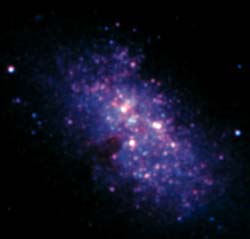Million-star cluster in nearby galaxy reported

Pseudo-color image of dwarf galaxy NGC 5253. <br>Blue: adapted from Hubble Space Telescope optical image; red: infrared image from the Keck Telescope. The supernebula/embedded million-star young cluster is the brightest infrared source, visible to the upper right of the central bright optical star cluster. Courtesy: D. Calzetti, Space Telescope Science <br>Institute. <br>
A small, bizarre cluster of a million young stars, enshrouded in thick gas and dust in a nearby dwarf galaxy, has been confirmed by Jean Turner, UCLA professor of physics and astronomy, and her colleagues, in the June 5 issue of the journal Nature.
Turner and her colleagues estimate that the stars are still in the process of forming, and are less than a million years old — extremely young by astronomical standards.
The cluster contains more than 4,000 massive “O” stars, each a million times brighter than our sun, with more than 30 times the mass of our sun. “O” stars blow off violent winds, and are the most luminous of all known stars. These “O” stars will become supernovae and explode at the end of their lives, but none has done so yet.
“This is the first time such a large cluster of ‘O’ stars, bound with its natal gas, has been observed anywhere in the universe,” Turner said. “These ‘O’ stars should not fit in this small region, yet somehow they do.”
The research is federally funded by the National Science Foundation.
The star cluster is buried within a “supernebula” consisting of hot gases in the galaxy NGC 5253, in the southern part of the sky, slightly above the horizon, in the constellation Centaurus. The supernebula is hidden from optical view by its own gases.
The astronomers used the Keck Observatory’s Near Infrared Spectrometer, an instrument built by Turner’s UCLA astronomy colleague, professor Ian McLean, to study the star cluster.
The stars are packed tightly in a region only three light years across — less than the distance from our sun to its closest neighbor star, Turner said.
The star cluster is surrounded by thick gases that move faster than 100,000 miles per hour — faster than the speed of sound — yet they are trapped by gravity.
“The dense gases are bound by the enormous gravity of the cluster, which makes this cluster different from any other known young cluster,” Turner said. “It’s truly a unique object. I originally titled this paper, ‘Supernebula in Gravitational Bondage.’ Clusters in our galaxy are not nearly as massive and cannot trap their gas.”
In the Milky Way, globular clusters containing hundreds of thousands of stars are billions of years old, having formed early in our galaxy’s history. Some astronomers had believed globular clusters could form only in the early universe, yet this nearby galaxy is forming globular clusters.
“It’s a mystery why this tiny galaxy can form globular clusters at the present time and the Milky Way can’t,” Turner said. “We hope to be able to solve this mystery. How a million stars can form in such a small region is also a mystery.”
The cluster has one billion times the luminosity of our sun, but is invisible in ordinary light. Turner’s team detected the cluster using infrared and radio observations. The astronomers detected the radio emission of the object in 1996, but needed the new infrared analyses to exclude possibilities other than the star cluster, and to see that the gases are trapped by gravity, Turner said.
Turner and her colleagues — Sara Beck, astronomy professor at Tel Aviv University’s School of Physics and Astronomy in Israel; former UCLA astronomy graduate students Lucian Crosthwaite and David Meier; James Larkin, assistant professor of physics and astronomy at UCLA; and Ian McLean, professor of astronomy at UCLA — analyzed infrared hydrogen spectra from NGC 5253, a galaxy that contains hundreds of large star clusters.
Turner and her colleagues will look for other examples of young star clusters, and hope to learn more about star formation within this cluster, using infrared and radio emissions.
“We haven’t observed this type of start formation before,” Turner said. “This globular cluster is invisible to ultraviolet telescopes, and could remain invisible for most of its star-forming lifetime.”
Media Contact
More Information:
http://www.ucla.edu/All latest news from the category: Physics and Astronomy
This area deals with the fundamental laws and building blocks of nature and how they interact, the properties and the behavior of matter, and research into space and time and their structures.
innovations-report provides in-depth reports and articles on subjects such as astrophysics, laser technologies, nuclear, quantum, particle and solid-state physics, nanotechnologies, planetary research and findings (Mars, Venus) and developments related to the Hubble Telescope.
Newest articles

Properties of new materials for microchips
… can now be measured well. Reseachers of Delft University of Technology demonstrated measuring performance properties of ultrathin silicon membranes. Making ever smaller and more powerful chips requires new ultrathin…

Floating solar’s potential
… to support sustainable development by addressing climate, water, and energy goals holistically. A new study published this week in Nature Energy raises the potential for floating solar photovoltaics (FPV)…

Skyrmions move at record speeds
… a step towards the computing of the future. An international research team led by scientists from the CNRS1 has discovered that the magnetic nanobubbles2 known as skyrmions can be…





















